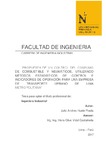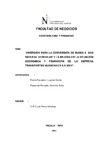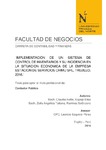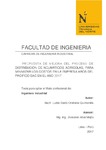| dc.contributor.advisor | Vidal Castañeda, Hans Clive | |
| dc.contributor.author | Huete Prada, Julio Andres | |
| dc.date.accessioned | 2017-12-07T17:02:49Z | |
| dc.date.available | 2017-12-07T17:02:49Z | |
| dc.date.issued | 2017-09-19 | |
| dc.identifier.citation | Huete, J. A. (2017). Propuesta de un control del consumo de combustible y neumáticos, utilizando métodos estadísticos de control e indicadores de operación para una empresa de transporte urbano de Lima Metropolitana (Tesis de licenciatura). Repositorio de la Universidad Privada del Norte. Recuperado de http://hdl.handle.net/11537/12544 | es_PE |
| dc.identifier.other | 670.7 HUET 2017 | es_PE |
| dc.identifier.uri | https://hdl.handle.net/11537/12544 | |
| dc.description.abstract | RESUMEN
En la presente tesis se propone un control del consumo de combustible y neumáticos utilizando métodos estadísticos e indicadores de operación para una empresa de transporte urbano público en Lima-Metropolitana que son los consumibles más importantes en relación a los costos operativos y tener así la finalidad de lograr el mejor desempeño operativa de la flota de transporte, garantizando un mejor servicio a los usuarios.
Actualmente no cuenta con un mecanismo que permita sistematizar y organizar la información que emana el área operativa; es por ello que surge la necesidad de desarrollar un proceso de control de combustible y neumáticos con el fin de aprovechar la data recopilada y crear graficas de control para su respectivo análisis con el fin de conocer la realidad de la flota de transporte.
Se describe la situación actual del área de operaciones, se realiza la recopilación de consumo de combustible a lo largo de un mes de un vehículo propio de la empresa y registrar el recorrido del día con su respectivo tiempo de duración del viaje. Esto permitió elaborar gráficos de control con cálculos de media, rango y desviación estándar y así determinar el consumo límite máximo y mínimo; este alcance permite analizar día a día en donde y porque ocurre un exceso de consumo y de esta manera ejecutar mejoras en el proceso.
En relación a los neumáticos la empresa de transporte no cuenta ninguna data de consumo y duración, datos de características, marca y modelo por lo tanto se realizó un cálculo de rendimiento teórico de acuerdo a las especificaciones técnicas que entrego el proveedor. A partir de la información se propone un control a los neumáticos de cada posición del vehículo representado en un flujo de proceso para su mejor entendimiento.
Los beneficios son los siguientes: El rendimiento actual de combustible es de 4.71 km/lt y el rendimiento proyectado de combustible es de 5.03 Km/lt, por lo que se concluye que el rendimiento de combustible se incrementa en un 6.36%. El costo por kilómetro del neumático disminuye en 17%, lo que significa una reducción del costo por kilómetro del neumático de 0.0047 a 0.0039. Se incrementó la eficiencia de la flota de transporte por un año de 0.32 a 0.53 que significa un aumento de 65%. La disponibilidad de la flota de transporte aumentará a un 80% al tener menos paradas por reparaciones y fallas en operación. La producción de la flota de transporte aumentará en un mes a 10,027 personas/ bus. Se proyectó un beneficio de ahorro de S/ 3 800.00 soles neto mensuales de consumo de combustible. | es_PE |
| dc.description.abstract | ABSTRACT
This thesis proposes a control of the consumption of fuel and tires using statistical methods and operating indicators for a public urban transport company in Lima-Metropolitan that are the most important consumables in relation to the operating costs and thus have the purpose of achieve the best operational performance of the transport fleet, ensuring a better service to users.
At the moment it does not have a mechanism that allows to systematize and to organize the information that emanates the operative area; this is why the need arises to develop a fuel and tire control process in order to take advantage of the data collected and create control charts for their respective analysis in order to know the reality of the transport fleet.
It describes the current situation of the area of operations, the fuel consumption is collected over a month of a company's own vehicle and record the journey of the day with its respective time of travel. This allowed the elaboration of control charts with mean, range and standard deviation calculations, thus determining the maximum and minimum limit consumption; this scope allows analyzing day by day where and why an excess of consumption occurs and in this way execute improvements in the process.
In relation to the tires the transport company does not count any data of consumption and duration, data of characteristics, mark and model therefore a calculation of theoretical performance was realized according to the technical specifications that I give the supplier. From the information it is proposed to control the tires of each vehicle position represented in a process flow for their better understanding.
The benefits are as follows: The current fuel efficiency is 4.71 km / lt and the projected fuel efficiency is 5.03 km / lt, which concludes that fuel efficiency increases by 6.36%. The cost per kilometer of the tire decreases by 17%, which means a reduction of the cost per kilometer of the tire of 0.0047 to 0.0039. The efficiency of the transport fleet for a year increased from 0.32 to 0.53, which means an increase of 65%. The availability of the transport fleet will increase to 80% by having fewer stops for repairs and failures in operation. The production of the transport fleet will increase in a month to 10,027 people / bus. A saving benefit of S / 3 800.00 net monthly soles of fuel consumption was projected. | es_PE |
| dc.description.uri | Tesis | es_PE |
| dc.format | application/pdf | es_PE |
| dc.language.iso | spa | es_PE |
| dc.publisher | Universidad Privada del Norte | es_PE |
| dc.rights | info:eu-repo/semantics/closedAccess | es_PE |
| dc.source | Universidad Privada del Norte | es_PE |
| dc.source | Repositorio Institucional - UPN | es_PE |
| dc.subject | Administración de procesos | es_PE |
| dc.subject | Ingeniería Industrial | es_PE |
| dc.subject | Transporte vehicular | es_PE |
| dc.subject | Transportes | es_PE |
| dc.title | Propuesta de un control del consumo de combustible y neumáticos, utilizando métodos estadísticos de control e indicadores de operación para una empresa de transporte urbano de Lima Metropolitana | es_PE |
| dc.type | info:eu-repo/semantics/bachelorThesis | es_PE |
| thesis.degree.grantor | Universidad Privada del Norte. Facultad de Ingeniería | es_PE |
| thesis.degree.level | Título Profesional | es_PE |
| thesis.degree.discipline | Ingeniería Industrial | es_PE |
| thesis.degree.name | Ingeniero Industrial | es_PE |
| dc.publisher.country | PE | es_PE |
| dc.subject.ocde | https://purl.org/pe-repo/ocde/ford#2.11.04 | es_PE |
| thesis.degree.program | Pregrado | es_PE |
| dc.description.sede | Los Olivos | es_PE |
| renati.advisor.dni | 19096152 | |
| renati.author.dni | 40872623 | |
| renati.discipline | 722026 | es_PE |
| renati.level | https://purl.org/pe-repo/renati/level#tituloProfesional | es_PE |
| renati.type | https://purl.org/pe-repo/renati/type#tesis | es_PE |





